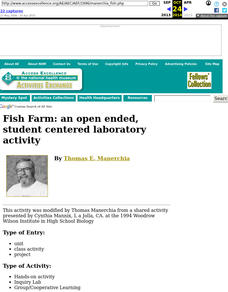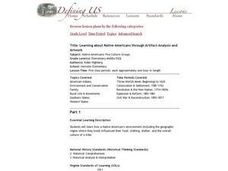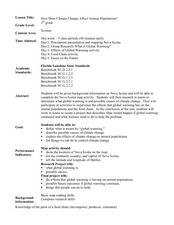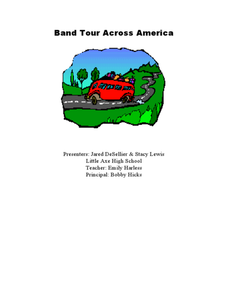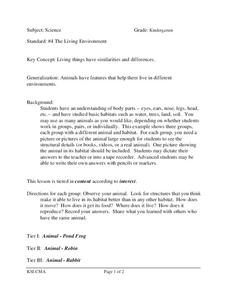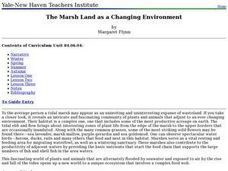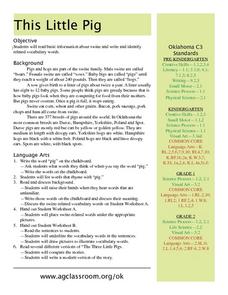Curated OER
Sustainable Island Development
Students explain how the basic human needs of a large group of people can be met. They describe and evaluate alternative methods for providing water and food, producing electricity, handling wastes, and transporting goods and people....
Curated OER
Sustainable Island Development
Students explain how the basic human needs of a large group of people can be met. They describe and evaluate alternative methods for providing water and food, producing electricity, handling wastes, and transporting goods and people....
Curated OER
Changing Climate, Changing Animals
Students review teacher-provided background materials on impact of climate change. Students then work in small groups to make poster on possible impacts of climate change on one particular northern animal, and how it might affect people...
Curated OER
Everyone Has a Culture -- Everyone is Different
Students are shown various statements and respond to each as a class. They discuss the differences between different groups of people and why they behave differently as well. After completing a worksheet, they discover aspects of their...
Curated OER
How Do You Make A Tornado?
Students create a tornado in a bottle. In this climate and weather lesson, students review basic information about tornadoes and thunderstorms. Students make a tornado in a bottle and write about what they learned from the project....
Curated OER
Fish Farm: an open ended, student centered laboratory activity
Students are contacted by a fictitious company which raises tropical fish to do basic research for them so that they might keep their production costs down. They need to know the optimum salinity in which to hatch the brine shrimp that...
Curated OER
Water, Water Everywhere (Pond Animals)
Second graders examine the characteristics of animals who live in a pond environment. In groups, they describe the various stages in the life of a frog and identify the characteristics of other pond animals. Using this information,...
Curated OER
Minerals of the Earth
Students learn and practice identifying Earth's minerals and their properties. Working in small groups, they evaluate minerals. This is a well-described lesson plan, which students enjoy.
Curated OER
Learning about Native Americans through Artifact Analysis and Artwork
Sixth graders assess how a Native American's environment and the geographic region where they lived influenced their food, clothing, shelter and the overall culture of a tribe. They study the impact of conservation, family, rural life,...
Curated OER
How Does Climate Change Affect Animal Populations?
Young scholars investigate the effect of climate change on animal population in Nova Scotia. In this environmental science lesson, students complete a Nova Scotia map activity and research the causes of global warming in small groups....
Curated OER
Band Tour Across America
Students plan the trip of a band across America. In this money planning lesson, students create a budget for the band using excel basic functions. They manage the band and its budget and relate the tour to future budgeting needs of the...
Curated OER
Connection to the Past
Students learn basic interviewing and biography writing skills. They first identify a senior citizen in their community who remembers the Great Depression.
Curated OER
Take an Ant to Lunch
Second graders construct a model of an ant, exemplifying that ants are insects. Students gather data create a pictograph chart to show ant food preferences. Also, 2nd graders access the Internet to explore ant eating habits.
Curated OER
An Orderly Wagon Train Migration
Sixth graders work in small groups to organize a wagon train for a trek westward. They determine leadership responsibilities and rules needed to make a successful trek.
Curated OER
Tornado In A Bottle
Students are able to visualize a tornado usig a simple experiment. They are divided into small groups. Students drill a 3/8 inch hole in the center of each bottle cap. Students connect the caps to the top of each other using glue. ...
Curated OER
How To Find a Site
Fourth graders identify the three basic needs of humans. They identify on a map the best places to live and make a list of items that they can find on a map - streams, river, hills, plains, forests, etc.
Curated OER
Oh Deer! and English Learner Writing Extensions
Students follow deer through Yellowstone Park and record the number of deer from year to year. In this basic needs of deer lesson, students work in small groups and chart the number of deer each year and give explanations using as...
Curated OER
The Living Environment
Students investigate animals and their environments. In this animal similarities and differences activity, students explore animal adaptations and features and their habitats. Students get into groups to discuss the habitat and how...
Curated OER
Don’t Cry Over Spoiled Milk!
Seventh graders explore how milk spoils over time. In this biology lesson, 7th graders discover how pH changes as microorganisms enter the food and multiply. They explain the benefits of pasteurization process.
Curated OER
How to: Build a Plant Cell
Students build a 3-dimensional model of a plant cell with household objects. In this plant biology lesson plan, students construct replica plant cells in groups of three. After completing their projects, students share their creations...
Curated OER
Safe Work Habits and First Aid - Level II
Identify and explain the appropriate use and care of basic kitchen equipment. Locate food preparation equipment in the laboratory Identify various types of kitchen equipment Select appropriate equipment for specific product preparation...
Curated OER
The Marsh Land as a Changing Environment
Sixth graders continue their examination of the state of Connecticut. After taking a field trip, they identify the types of birds, plants, invertebrates and vertebrates who make their home in the salt marshes. In groups, they identify...
Curated OER
What's Wild
Third graders discover the differences between wild and domestic animals. In this animal lesson plan, 3rd graders chart the differences in the animals and look through magazines for pictures of wild and domestic animals to glue to a...
Curated OER
This Little Pig
First graders study basic information about swine. They write and identify vocabulary words relating to the subject. They write a recipe for "Pigs in a Blanket," using canned crescent rolls and small sausages. They trade recipes and...
Other popular searches
- Five Basic Food Groups
- Four Basic Food Groups
- 4 Basic Food Groups
- 5 Basic Food Groups
- Basic Food Groups Free
- 3 Basic Food Groups
- Basic Food Groups Worksheets





